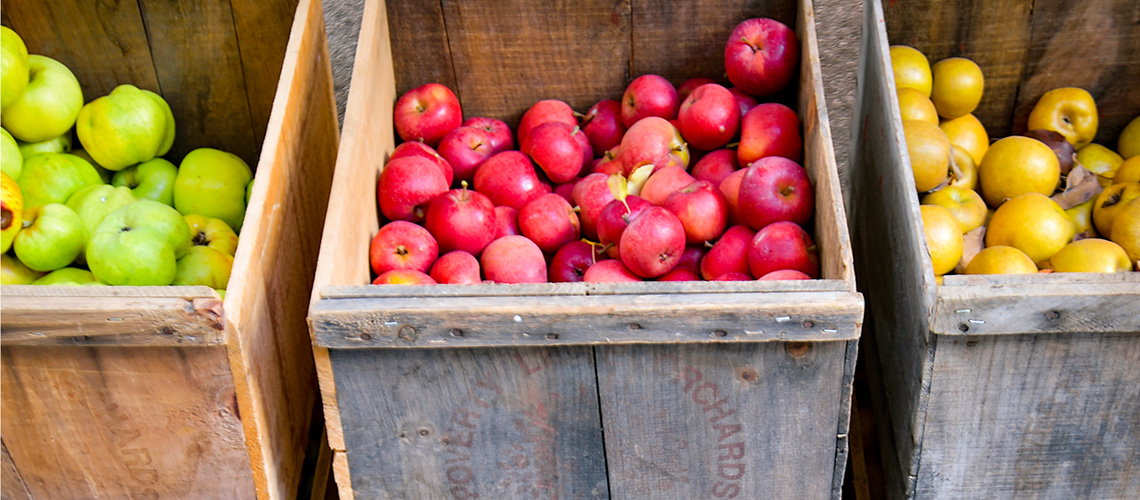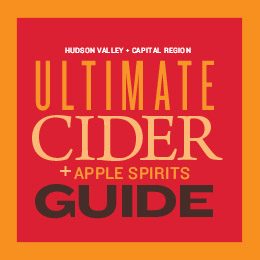
THERE’S NO DENYING the popularity of cider is on the rise. At least one commercially-produced cider can be found in your local grocery store, deli, or bodega—something just not available as recently as five years ago. What you’ll find on these shelves is a good introduction to the joys of drinking cider, but they lead many to assume cider is always a sweet beverage. Not all ciders fall into this range. The craft cider industry is busting this myth with a variety of styles and flavors to suit all tastes.
Most Hudson Valley cider houses produce a range of styles. Some craft styles that mirror their favorite type of European cider, generally English, Spanish, or French. English cider is known for being dry and tannic with higher alcohol levels, while Spain is known for ciders with racing acidity, slight funk, and bright green, somewhat herbal, flavors. The French create sweeter, lower-alcohol ciders with lively effervescence.
Building on these traditions, creativity and experimentation is rampant among local producers. Each cider maker brings his or her distinct personality into the mix by using a unique blend of apples or adding surprise elements like spices and other fruits, or by maturing their ciders in different types of vessels.
It’s true the best way to learn about cider styles is by drinking them, but you can also learn a lot—and define your own cider style—by understanding the terminology commonly used in the craft cider industry.
OFF-DRY CIDER
Off-dry ciders have slightly more body than their dry counterparts; usually containing 1% to 2% residual sugar. A rounder, fuller mouthfeel is the norm here, while the cider still contains enough acid to be refreshing. This is an excellent choice for food pairing. The slight sweetness plays nicely with spicy cuisine including Indian, Thai and BBQ.
TRY: Brooklyn Cider House produces a stellar off-dry style that truly fits the bill in this category.
DRY CIDER
Dry ciders generally have less than 0.5% residual sugar. They are often tannic, with a pronounced acidity, and a slightly thinner body than those with more residual sugar. Depending on the apple varieties used, aromas can include spring blossoms, wild flower, and sweet clover. Most styles of dry cider contain enough rich fruit essence to stand up against lightly spiced cuisine. They also complement any type of grilled bratwurst, many different cheeses, and they pair perfectly with a variety of charcuterie and pâtés. Many cider makers in the Hudson Valley craft a dry cider.
TRY: Top picks include those from Hardscrabble Cider, Kettleborough Cider House, and Indian Ladder Farmstead Cidery.
BONE-DRY CIDER
This style is often made with cider apple varieties which add more tannin and a spine-tingly acidity to the finished product. Pleasant earthy notes combine with interesting flavors and exotic aromas to make this mouthwatering style of cider. While this style may take some getting used to for newbies, it’s a favorite among aficionados. For pairings, treat this like a French Chablis – briny raw shellfish, such as oysters and clams, are charmed out of their shells by this style of cider.
TRY: Pennings Farm Cidery and Brooklyn Cider House both produce bone-dry ciders worth seeking out.
BOTTLE CONDITIONED
Produced much like sparkling wine, with a second fermentation occurring in bottle. Not only does bottle conditioning add satisfying and elegant natural carbonation, the live yeast creates complex flavor profiles. These thought-provoking sparkling ciders pair with buttery seafood preparations, pasta with cream sauce, or triple crème cheeses.
TRY: Orchard Hill Cider Mill and Treasury Cider craft tasty examples of this labor-intensive style. Hudson Valley Farmhouse Cider offers several savory ciders in this style which are bottle conditioned in their new temperature-controlled facility.
SCRUMPY
Traditionally Scrumpy was a strong, rough, very pulpy cider, cloudy in appearance, and popular in Western England. In the 19th century, farm laborers would generally receive up to a quart daily as an incentive on top of their wages. Today, Scrumpy can be mildly sweet or dry, but it is almost always cloudy due to its unique production method. True Scrumpy is made using the natural yeast found in apples, slowly fermented over a long period of time which produces its natural effervescence. Scrumpy can be bottled with the addition of honey or other sweeteners, and yeast is sometimes added to boost the alcohol and create more bubbles. It can then be left to finish for an additional two or more months. It’s no wonder this rustic beauty has inspired more than one indie folk punk ballad dedicated to its delights. Scrumpys, which are often sold in jugs, are welcome at any BBQ featuring hearty grilled meats and mayo-laden salads, and best in the company of friends and family. TRY: Hudson Valley Farmhouse Cider produces a seasonal Scrumpy that is bottled alive so it must be kept cold or refrigerated. This New York take on an English tradition is a win-win on either continent.
SWEET
For those that prefer a sweeter style cider, there are many farm-fresh options to choose from. Instead of the commercial brands, which typically contain fifty percent juice and rely on added sugar to achieve a fuller flavor, there are lush orchard fruit ciders and versions back-sweetened with local honey being crafted in the Hudson Valley. These styles are delicious paired with strong washed-rind or blue cheeses.
TRY: Weed Orchards’ Papa’s Peaches Hard Cider, or honey ciders from Penning’s Farm Cidery and Standard Cider Co.
CROSSOVER STYLES
Most cider makers are purists and let the terroir of the orchard and the character of the apples weave the story that ends up in the glass. But some can’t help being rebels, commingling flavors from other facets of the beverage industry to influence their finished products. Dry-hopped ciders, for example, have citrus flavors and floral notes that are not only more refreshing than an IPA beer, they are also much less filling.
TRY: Standouts include Bad Seed Cider’s IPC Hopped Cider and Joe Daddy’s Hoppin’ Joey. Naked Flock’s Currant Saison is a crossover that would satisfy any beer lover’s palate.
Other alternative cider styles take their cues from wine. Try Nine Pin Ciderworks’ Cidre Rosé, made by co-fermenting apples with the skins of red grapes to create a pink tipple perfect for summer sipping, with a lower alcohol than your average rosé. For those seeking a more assertive flavor, barrel-aged ciders offer up flavors of spice, a touch of smoky character, and a bit of heft. Angry Orchard’s small batch barrel-aged ciders stamp a distinctly Hudson Valley signature on this traditionally European style of cider.
The talented cider pioneers throughout the region are crafting many palate-pleasing styles of ciders—from sweet to bone-dry. You just may have to try them all to discover a few go-to styles to call your own.
By Wendy Crispell
Photo: Eric Lewandowski
